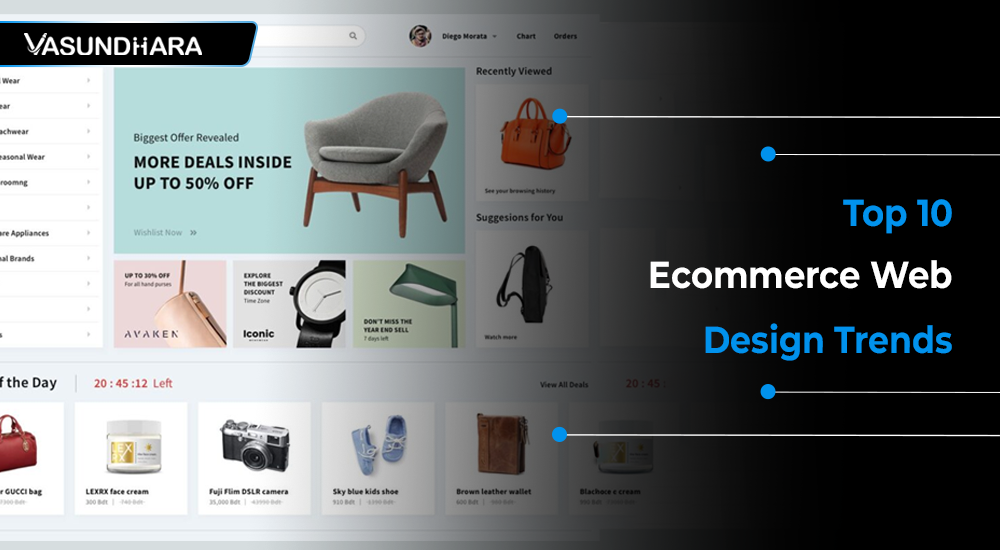The world of e-commerce is evolving rapidly, and staying ahead of the competition requires more than just great products and services. A well-designed e-commerce website is crucial for attracting and retaining customers. As consumer preferences and technology continue to shift, businesses must adapt to emerging web design trends to ensure an optimized shopping experience.
From AI-powered personalization to immersive AR/VR shopping experiences, the latest trends in e-commerce web design and development focus on user engagement, convenience, and security. In this blog, we explore the top 10 e-commerce web design trends shaping the future of online shopping in 2024.
1. Minimalist & Clean UI
Minimalism in creative web design continues to be a dominant trend, especially in the e-commerce industry. A clutter-free, well-structured, and visually appealing interface enhances user experience by ensuring effortless navigation and quick access to products.
Why It Matters:
- Reduces cognitive load, making it easier for customers to browse and make purchasing decisions.
- Improves website loading speed, which directly impacts conversions and SEO rankings.
- Enhances mobile responsiveness, making sites adaptable across various devices.
How to Implement:
- Use ample whitespace to create a sleek and modern aesthetic.
- Focus on high-quality product images with concise descriptions.
- Implement a simple color palette that aligns with your brand identity.
Popular brands like Apple and Nike leverage minimalist design to create seamless shopping experiences that keep users engaged without distractions.
2. AI-Powered Personalization
Artificial intelligence (AI) has revolutionized the way e-commerce businesses interact with customers. AI-powered personalization tailors the shopping experience based on user preferences, past behavior, and real-time interactions.
Why It Matters:
- Increases customer engagement and sales by offering personalized product recommendations.
- Enhances customer satisfaction through AI-driven chatbots and virtual assistants.
- Boosts retention by providing a tailored experience for each user.
How to Implement:
- Use AI algorithms to analyze user data and recommend relevant products.
- Deploy chatbots that assist customers with product inquiries and support.
- Implement dynamic pricing strategies based on user behavior and demand.
E-commerce giants like Amazon and Netflix use AI to create highly personalized experiences that drive customer loyalty and sales.
3. Mobile-First Design
With mobile commerce (m-commerce) on the rise, businesses must prioritize mobile-first design to cater to smartphone users.
Why It Matters:
- More than 70% of e-commerce sales now come from mobile devices.
- Google prioritizes mobile-friendly websites in search rankings.
- Enhances user convenience by allowing seamless shopping on the go.
How to Implement:
- Use responsive design to ensure compatibility across all screen sizes.
- Optimize images and content for faster mobile loading speeds.
- Simplify navigation with thumb-friendly buttons and intuitive interfaces.
Brands like ASOS and Zara have mobile-optimized websites that offer smooth, app-like experiences for users.
4. Dark Mode for E-commerce Sites
Dark mode is becoming increasingly popular as it offers a visually appealing alternative to traditional light themes.
Why It Matters:
- Reduces eye strain, especially for users who shop at night.
- Saves battery life on OLED and AMOLED screens.
- Creates a modern and elegant aesthetic.
How to Implement:
- Offer a toggle option for users to switch between light and dark modes.
- Optimize contrast and readability for product images and text.
- Use dark mode to highlight important call-to-action buttons effectively.
Brands like Adidas and Shopify have successfully integrated dark mode to enhance user engagement.
5. Microinteractions & Animations
Microinteractions enhance user engagement by providing real-time feedback and interactive elements.
Why It Matters:
- Makes the shopping experience more dynamic and enjoyable.
- Provides immediate feedback on actions like adding items to the cart.
- Improves navigation and guides users through the buying journey.
How to Implement:
- Use hover effects on product images for quick previews.
- Add subtle animations to buttons and transitions.
- Implement loading animations that keep users engaged while content loads.
E-commerce platforms like Etsy and Amazon use microinteractions to create a more intuitive shopping experience.
6. AR/VR Shopping Experiences
Augmented reality (AR) and virtual reality (VR) are redefining online shopping by allowing customers to interact with products in a more immersive way.
Why It Matters:
- Helps customers make informed decisions by visualizing products in real-world settings.
- Reduces return rates by offering realistic previews.
- Increases engagement and brand trust.
How to Implement:
- Use AR for virtual try-ons (fashion, eyewear, makeup, etc.).
- Implement VR showrooms for a more immersive product experience.
- Offer 3D models of products to enhance visualization.
Brands like IKEA and Sephora have successfully integrated AR/VR to improve online shopping experiences.
7. Voice Commerce Integration
Voice commerce is gaining traction with the rise of virtual assistants like Alexa and Google Assistant.
Why It Matters:
- Provides a hands-free, convenient shopping experience.
- Optimizes product searches for voice commands.
- Enhances accessibility for differently-abled users.
How to Implement:
- Optimize product descriptions for voice search queries.
- Integrate voice command features in mobile apps.
- Ensure compatibility with smart home assistants.
Major retailers like Walmart and Target are leveraging voice commerce to enhance user convenience.
8. Sustainability-Focused Design
Sustainability in creative web design is becoming a priority as consumers demand eco-friendly business practices.
Why It Matters:
- Reduces environmental impact by optimizing website resources.
- Aligns with consumer values, enhancing brand reputation.
- Encourages responsible shopping behavior.
How to Impement:
- Use eco-friendly hosting services that reduce carbon footprints.
- Optimize images and code for energy-efficient browsing.
- Highlight sustainable products and business practices.
Brands like Patagonia and Allbirds emphasize sustainability in both product offerings and web design.
9. One-Page Checkout & Seamless Payment
Simplifying the checkout process is key to reducing cart abandonment.
Why It Matters:
- Increases conversions by minimizing friction in the buying process.
- Provides a faster, more intuitive shopping experience.
- Enhances security and trust with streamlined payment options.
How to Implement:
- Offer one-page checkout to reduce unnecessary steps.
- Integrate digital wallets like Apple Pay, Google Pay, and BNPL (Buy Now, Pay Later) options.
- Ensure secure payment gateways and SSL encryption.
Amazon’s one-click checkout is a prime example of seamless payment integration.
10. Advanced Security & Trust Badges
Website security is a top priority for building customer trust and preventing fraud.
Why It Matters:
- Protects customer data from cyber threats.
- Enhances credibility and customer confidence.
- Prevents chargebacks and fraudulent transactions.
How to Implement:
- Display SSL certificates and trust badges.
- Use two-factor authentication (2FA) for secure transactions.
- Incorporate AI-powered fraud detection systems.
Conclusion
Adapting to the latest e-commerce web design trends is essential for businesses aiming to enhance user experience, drive conversions, and stay competitive. From AI-powered personalization to seamless checkout processes, these trends are shaping the future of online shopping.
Looking to revamp your e-commerce website with the latest design trends? As a leading e-commerce software development company and trusted e-commerce website design agency, we offer innovative and customized e-commerce web development solutions that elevate your online store to the next level. Contact us today to get started on transforming your online business with cutting-edge design and functionality!




